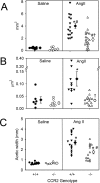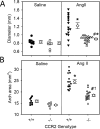Angiotensin II infusion promotes ascending aortic aneurysms: attenuation by CCR2 deficiency in apoE-/- mice
- PMID: 20088827
- PMCID: PMC2841499
- DOI: 10.1042/CS20090372
Angiotensin II infusion promotes ascending aortic aneurysms: attenuation by CCR2 deficiency in apoE-/- mice
Abstract
AngII (angiotensin II) induces atherosclerosis and AAAs (abdominal aortic aneurysms) through multiple proposed mechanisms, including chemotaxis. Therefore, we determined the effects of whole-body deficiency of the chemokine receptor CCR2 (CC chemokine receptor 2) on these diseases. To meet this objective, apoE (apolipoprotein E)-/- mice that were either CCR2+/+ or CCR2-/-, were infused with either saline or AngII (1000 ng.kg-1 of body weight.min-1) for 28 days via mini-osmotic pumps. Deficiency of CCR2 markedly attenuated both atherosclerosis and AAAs, unrelated to systolic blood pressure or plasma cholesterol concentrations. During the course of the present study, we also observed that AngII infusion led to large dilatations that were restricted to the ascending aortic region of apoE-/- mice. The aortic media in most of the dilated area was thickened. In regions of medial thickening, distinct elastin layers were discernable. There was an expansion of the distance between elastin layers in a gradient from the intimal to the adventitial aspect of the media. This pathology differed in a circumscribed area of the anterior region of ascending aortas in which elastin breaks were focal and almost transmural. All regions of the ascending aorta of AngII-infused mice had diffuse medial macrophage accumulation. Deficiency of CCR2 greatly attenuated the AngII-induced lumen dilatation in the ascending aorta. This new model of ascending aortic aneurysms has pathology that differs markedly from AngII-induced atherosclerosis or AAAs, but all vascular pathologies were attenuated by CCR2 deficiency.
Figures





References
-
- Weiss D., Kools J. J., Taylor W. R. Angiotensin II-induced hypertension accelerates the development of atherosclerosis in ApoE-deficient mice. Circulation. 2001;103:448–454. - PubMed
-
- Deng G. G., Martin-McNulty B., Sukovich D. A., Freay A., Halks-Miller M., Thinnes T., Loskutoff D. J., Carmeliet P., Dole W. P., Wang Y. X. Urokinase-type plasminogen activator plays a critical role in angiotensin II-induced abdominal aortic aneurysm. Circ. Res. 2003;92:510–517. - PubMed
-
- Bruemmer D., Collins A. R., Noh G., Wang W., Territo M., Arias-Magallona S., Fishbein M. C., Kintscher U., Fleck E., Law R. E., Hsueh W. A. Angiotensin II accelerated atherosclerosis and aneurysm formation is attenuated in osteopontin deficient mice. J. Clin. Invest. 2003;112:1318–1331. - PMC - PubMed
-
- Ishibashi M., Egashira K., Zhao Q., Hiasa K. I., Ohtani K., Ihara Y., Charo I. F., Kura S., Tsuzuki T., Takeshita A., Sunagawa K. Bone marrow-derived monocyte chemoattractant protein-1 receptor CCR2 is critical in angiotensin II-induced acceleration of atherosclerosis and aneurysm formation in hypercholesterolemic mice. Arterioscler. Thromb. Vasc. Biol. 2004;24:e174–e178. - PubMed
Publication types
MeSH terms
Substances
Grants and funding
LinkOut - more resources
Full Text Sources
Other Literature Sources
Medical
Research Materials
Miscellaneous

